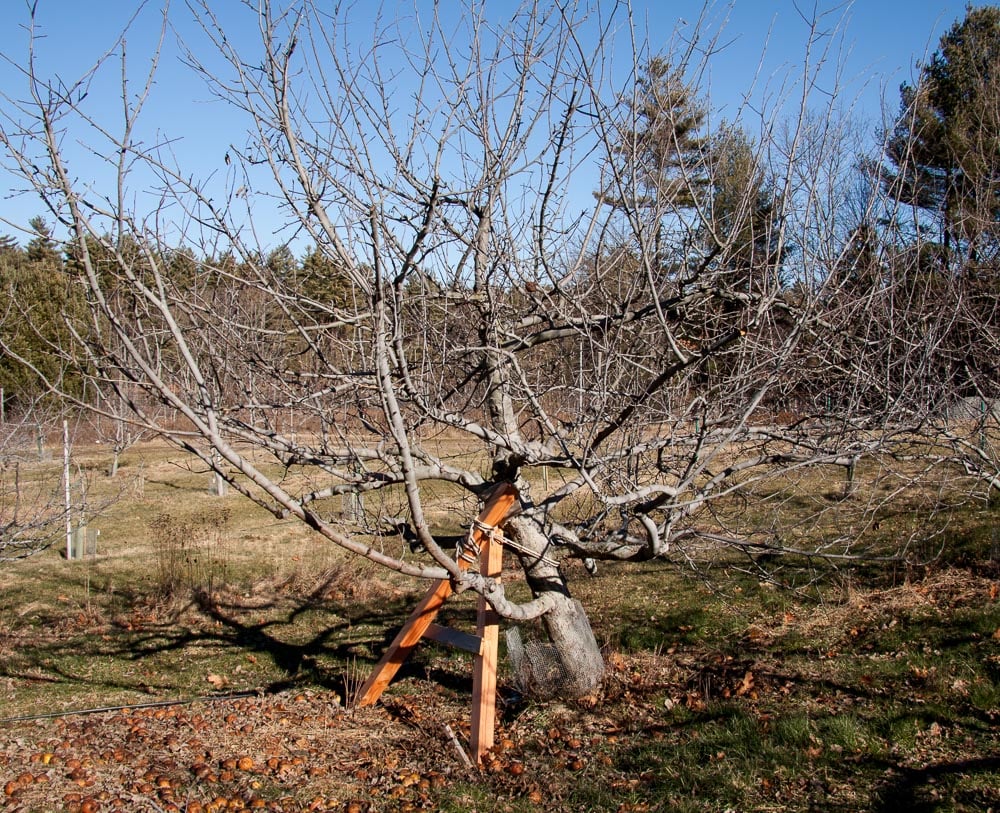Last week I got an email from our local Harvard weekly newspaper asking about the crop this year.
Hi Linda,
I’m doing a piece this week on this year’s apple crop damage. Frank Carlson is estimating a crop that will be about 50 to 75 percent of an average year’s crop. Are you seeing that kind of damage to your crop? He said his Cortlands were hit the hardest, but Macs are also off.
Are your raspberries ok?
Let me know, sad year for the orchards, especially those who grow peaches.
Thanks,
Joan
Frank Carlson is the patriarch of the orchard world in Harvard. When I first decided to bring back our trees, I called him. I felt shy about disturbing the man who was running the largest orchard in town, but I needed to make a connection with someone who knew about apples. Frank told me to come by, but when I arrived, I wasn’t really sure why I was there. It was harvest time, and there were towers of wooden crates filled with freshly picked apples. Frank was a mini-cyclone, answering his pager, cell phone, and loudspeaker calls, but he still took the time to chat with me in between answering questions that came at him from all sides.
Nodding, he said, “I’m familiar with A & M Orchards.” I told him that its new name was Old Frog Pond Farm and that I wanted to grow organic apples. “A small operation that is organic might work,” he continued. I sensed a sympathetic familiarity among anyone growing apples. I appreciated Frank’s openness and drove away with a glimmer of hope. This year is a different story.
I wrote back to the Harvard Press reporter,
Dear Joan,
Yes - a sad year!
Our apples are certainly down 50 percent. It is variety dependent. The late flowering ones are all right, but varieties that flowered early were killed off by the frost.
Raspberries are doing well and it seems like a bumper crop of blueberries.
We have a few peaches…enough for us to eat; but indeed a very sad year for peach growers.
I think climate change is wreaking havoc with our perennial fruit crops. They suffer from these wild temperature fluctuations early in the season when the buds and blossoms are so vulnerable.
Linda
Climate change is the biggest factor affecting all of us. Plants don’t evolve as quickly as climate change is happening. Some good news is that one approach to lowering the amount of carbon dioxide in the atmosphere is to store more carbon in the soil. The soil benefits, the plants benefit, and the earth becomes healthier.
Much of the carbon originally came from the soil and was released into the atmosphere since the industrial revolution. We have agreed that we need to reduce the carbon in the atmosphere but where can it go? Water covers 70 percent of our planet and when carbon combines with water it forms carbonic acid raising the acidity of the water and killing off plant life. Soil can take back and store carbon if we change our approach to industrial agriculture and land use.
One of the most important practices is to cover every square foot of soil with plants. Erosion is a number one cause of the loss of carbon. The second practice is to avoid tilling the soiling or minimally till. Tilling exposes soil to the air and releases carbon. Plants do the opposite through photosynthesis. Even if our fruit trees aren’t producing peaches and apples, they are removing carbon from the atmosphere.
The French government recently put forward an initiative, 4p1000.org with the goal of mitigating climate change effects through agriculture. Already 28 countries have signed on including France, Mexico, Japan — no, not the United States. The benefit of carbon rich soils is that the plants become more resilient. When we eat the food produced by these healthier plants, human health also improves.
While this year we may not have a good apple crop, hopefully by continuing to support our trees and encouraging their growth, they will become stronger and be able to adjust better to the fluctuations in temperatures that are certainly going to be part of our lives for the next decades. Climate Change Boston has just released their projections for Boston that include 90 days of summer over 90 degrees, which is essentially all of summer.
Still, it’s a sad year for fruit growers and the reason I have been avoiding writing about apples. The trees may be luscious with leaves, but there is really very little fruit. Truthfully, my estimate is far less than 50 percent, but I hate to say it. It’s so disappointing, and then I think that maybe I did something wrong, or that I could have done something differently.
Frank Carlson said that people are already calling for peaches. Their annual peach festival attracts a large following every year. It won’t happen this year, but they will be celebrating their 80th anniversary this summer. When the fruit is not as plentiful, your orchards need your support even more. Even if our apples aren’t plentiful, we hope you will come for raspberry picking, vegetables, workshops, our Plein Air Poetry Walk, and Outdoor Sculpture exhibits. This year we celebrate our 15th anniversary!








